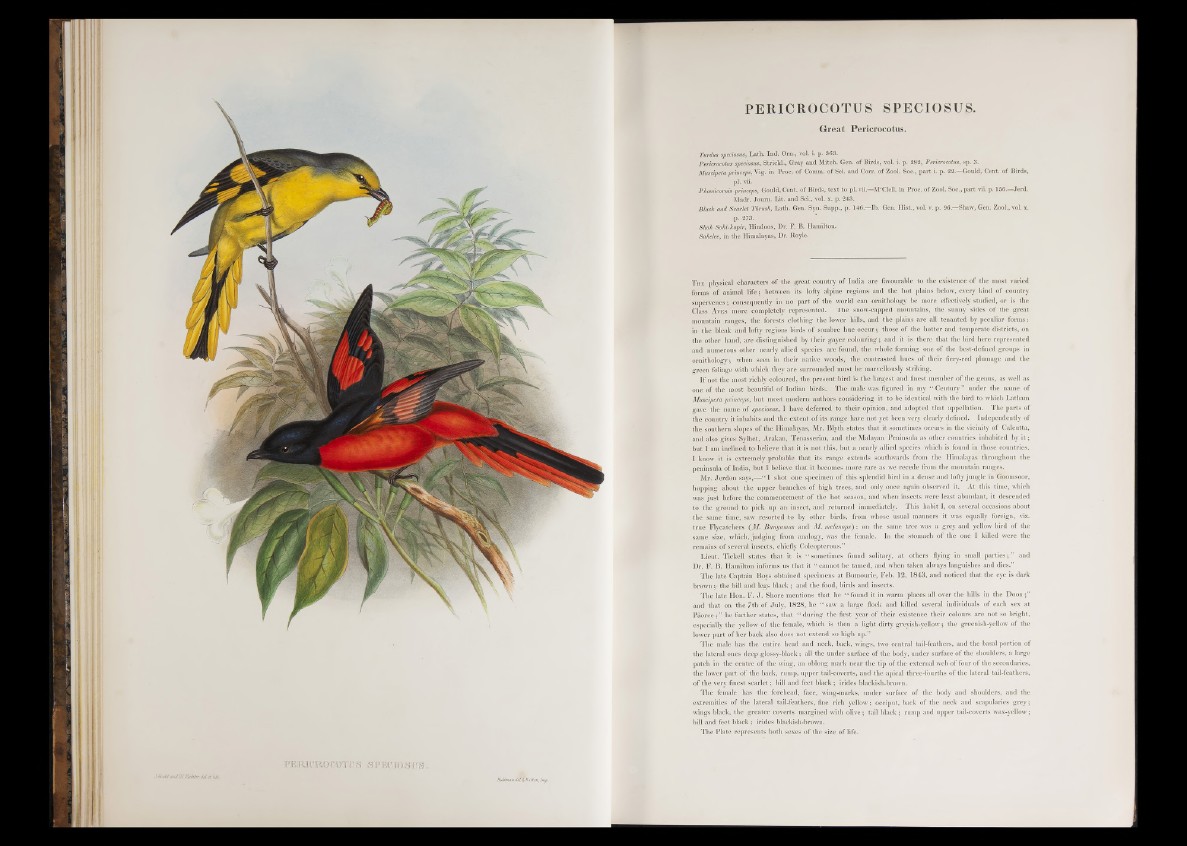
J.GouU anillllC Jicchl^ d il. ebTiih
F E R IC R O C O T T U f t O T E C IO S F S o
PERICROCOTUS SPECIOSUS.
Great Pericrocotus.
Turdus speciosus, Lath. Ind. Orn., vol. i. p. 363.
Pericrocotus speciosus, Strickl., Gray and Mitch. Gen. of Birds, vol. i. p. 282, Pericrocotus, sp. 3.
Muscipeta princeps, Vig. in Proc. of Comm, of Sci. and Corr. of Zool. Soc., part i. p. 22.—Gould, Cent, of Birds,
pi. vii.
Phcenicornis princeps, Gould, Cent, of Birds, text to pi. vii.—M'Clell. in Proc. of Zool. Soc., part vii. p. 156.—Jerd.
Madr. Joum. Lit. and Sci., vol. x. p. 243.
Black and Scarlet Thrush, Lath. Gen. Syn. Supp., p. 146.—Ib. Gen. Hist., vol. v. p. 96.—Shaw, Gen. Zool., vol. x.
p.. 273.
Shah Soki-kapir, Hindoos, Dr. F. B. Hamilton.
Sahelee, in the Himalayas, Dr. Royle.
T h e physical characters o f the great country of India are favourable to the existence of the most varied
forms of animal life; between its lofty alpine regions and the hot plains below, every kind of country
supervenes ; consequently |ii|n o part of the world can ornithology be more effectively studied, or is the
Class A ves more completely represented. The snow-capped mountains, the sunny sides of the great
mountain ranges, the forests clothing the lower hills, and the plains are all tenanted by peculiar forms:
in the bleak and lofty regions birds of sombre hue occur; those of the hotter and temperate districts, on
the other hand, are distinguished by their gayer colouring; and it is there that the bird here represented
and numerous other nearly allied species are found, the whole forming one of the best-defined groups in
ornithology; when seen in their native woods, the contrasted hues of their fiery-red plumage and the
green foliage with which they are surrounded must be marvellously striking.
If not the most richly coloured, the present bird is the largest and finest member of the genus, as well as
one of the most beautiful of Indian birds. The male was figured in my “ Century ” under the name of
Muscipeta princeps, but most modern authors considering it to be identical with the bird to which Latham
gave the name of speciosus, I have deferred to their opinion, and adopted that appellation. The parts of
the country it inhabits and the extent of its range have not yet been very clearly defined. Independently of
the southern slopes of the Himalayas, Mr. Blyth states that it sometimes occurs in the vicinity of Calcutta,
and also gives Sylhet, Arakan, Tenasserim, and the Malayan Peninsula as other countries inhabited by i t ;
but I am inclined to believe that it is not this, but a nearly allied species which is found in those countries.
I know it is extremely probable that its range extends southwards from the Himalayas throughout the
peninsula of India, but I believe that it becomes more rare as we recede from the mountain ranges.
Mr. Jerdon s a y s ,- fill shot one specimen of this splendid bird in a dense and lofty jungle in Goomsoor,
hopping about the upper branches of high trees, and only once again observed it, At this time, which
was just before the commencement of the hot season, and when insects were least abundant, it descended
to the ground to pick up an insect, and returned immediately. This habit I, on several occasions about
the same time, saw resorted to by other birds, from whose usual manners it was equally foreign, viz.
true Flycatchers (M . Banyumas and M. melanops) : on the same tree was a grey and yellow bird of the
same size, which, judging from analogy, was the female. In the stomach of the one I killed were the
remains of several insects, chiefly Coleopterous.”
Lieut. Tickell states that it is “ sometimes found solitary, at others flying in small parties; ” and
Dr. F. B. Hamilton informs us that it “ cannot be tamed, and when taken always languishes and dies.”
The late Captain Boys obtained specimens at Bumourie, Feb. 12, 1843, and noticed that the eye is dark
brown ;• the bill and legs black; and the food, birds and insects.
The late Hon. F. J . Shore mentions that he “ found it in warm places all over the hills in the Doon;”
and that on the 7th of July, 1828, he “ saw a large flock and killed several individuals of each sex at
Paoree; ” he further states, that “ during the first year of their existence their colours are not so bright,
especially the yellow of the female, which is then a light dirty greyish-yellow; the greenish-yellow of the
lower part of her back also does not extend so high up.”
The male has the entire head and neck, back, wings, two central tail-feathers, and the basal portion of
the lateral ones deep glossy-black; all the under surface of the body, under surface o f the shoulders, a large
patch in the centre of the wing, an oblong mark near the tip of the external web o f four of the secondaries,
the lower part of the back, rump, upper tail-coverts, and the apical three-fourths of the lateral tail-feathers,
of the very finest scarlet; bill and feet black; irides blackish-brown.
The female has the forehead, face, wiug-marks, under surface of the body and shoulders, and the
extremities of the lateral tail-feathers, fine rich yellow; occiput, back of the neck and scapularies g rey ;
wings black, the greater coverts margined with olive; tail black; rump and upper tail-coverts wax-yellow;
bill and feet black ; irides blackish-brown.
The Plate represents both sexes of the size of life.